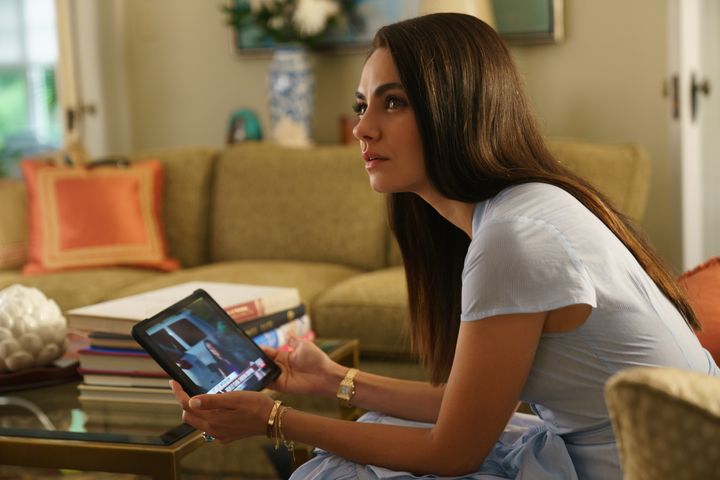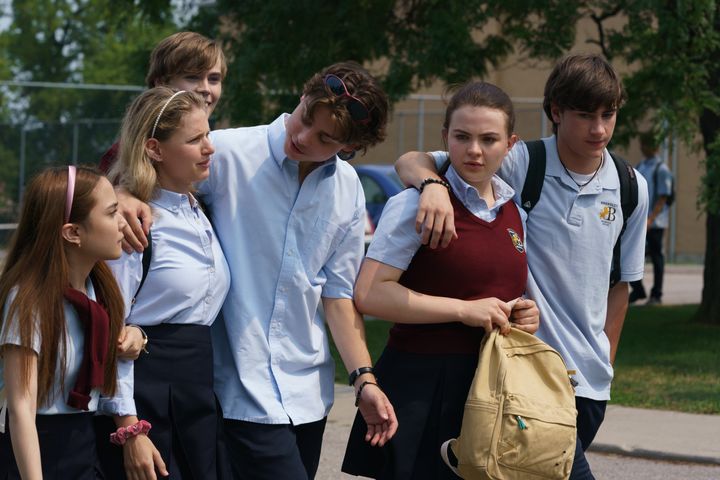
TW: This article contains discussion of rape and other forms of sexual assault.
Some have called it “the most powerful thing” they’ve ever watched. Others have think it’s an “insult to survivor’s of sexual assault”. The one thing viewers seem to agree on, is that Luckiest Girl Alive makes for very difficult watching.
The newly-released Netfilx film, starring Mila Kunis, is an adaptation of the novel of the same name by Jessica Knoll. It follows journalist Ani Fanelli, whose life looks picture-perfect until a documentary-maker asks to speak to her about the school shooting she survived in her teens.
As her past is revealed, viewers learn that Fanelli was gang raped as a teenager by three of her classmates – including her high school boyfriend – and each violation is shown in graphic detail on screen.
Though Netflix briefly mentions “sexual violence” and “threat” at the top of the screen when the film starts, many viewers have said this in an inadequate trigger warning, considering the length and detail of the visually disturbing scene.
Writing in the Independent, journalist Olivia Petter questioned whether “scenes as graphic as these could serve only to reinforce problematic myths around rape and isolate survivors whose experience don’t fit a very small and specific mould.”
Petter pointed out that sexual assault isn’t always physically violent to the same degree, and that in many cases, women are left questing whether their experience “counts” as rape.
But on social media, others have praised the film, with many urging viewers to tune in.
Rachel Thompson, author of Rough, which explores sexual violence and the systems of oppression that enable it, is “not remotely surprised” by the divided opinion of the film.
“I think it’s really positive to see people questioning the on-screen depictions of sexual violence and how they serve the wider conversation about trauma and violence,” she tells HuffPost UK.
“People are paying critical attention to what they’re seeing and I think that’s a really great thing. That said, I think a lot needs to change in the way sexual violence is portrayed on screen and the reaction to this film highlights that.”
Thompson, who writes about her own experience of assault in her book, says that, personally, she experienced “mixed feelings” about Luckiest Girl Alive.
“The graphic scenes of sexual violence were upsetting to watch and deeply triggering, and the fact they were presented in such close succession felt relentless. I just felt like, ‘Ok, when is this going to end?’” she says.
“On the other hand, I thought the portrayal of the aftermath of Ani’s rape was handled well. It showed the complexity of the aftermath of trauma and many aspects of sexual violence that people can relate to — people gaslighting you with questions like ‘are you sure that’s what happened?’ and people invalidating your experience or conflating it with consensual sex.”
But Thompson does not think the trigger warnings on the Netflix film were sufficient (she only spotted a reference to ‘sexual violence’ when she clicked on the listing’s description).
Netflix is yet to publicly respond to calls for a more prominent warning.
Jayne Butler, CEO of Rape Crisis, says it’s vital that viewers can make an informed choice about watching such scenes as “any representation of sexual violence in the media... can be extremely traumatising for victims and survivors - many of whom are still coping with the negative impacts of their experiences.”
As she tells HuffPost UK: “The prevalence of rape and sexual assault in society mean that it will inevitably feature in popular culture, and there are clear opportunities for TV shows and films to help shape the narrative around sexual violence. But to do this, there must be consultation with victims, survivors and specialist support organisations to ensure that content is not damaging.
“Trigger warnings are a start, but there also needs to be support information following TV shows and films so that those who are triggered know what their options are for support.”

One reason for the show’s mixed reviews – even among those who’ve experience rape or assault, some viewers have responded with praise – is because there is no right way to respond to the content. For some, these plot lines may feel validating, while for others, they’ll be highly triggering.
Thompson believes the film did a good job of showing “the disparity in what we think is the ‘correct’ way to process trauma and the reality of living with trauma”.
“In the immediate aftermath, Ani’s friend Arthur is angry at her for not standing up for herself — in actual fact, Ani’s is a really common trauma response,” she says.
“Ani’s fiancé’s comment that ‘you used to be fun’ in response to her having written about being raped is also far too relatable and shows that people expect survivors to simply move on and get over it. The reality is very different.”
Every time we see these debates play out online, it’s a reminder that we need to tackle the root cause of violence against women and girls. Because one thing is clear from the mass response to this movie: the problem is endemic.
One of the primary reasons for this is because it’s so normalised, says Sophie Gallagher, author of How Men Can Help.
“This happens in various ways through our culture, our media, in the way we talk about women, in the assumptions we make, in the way that men are taught to perform ‘masculinity’, and many others,” she tells HuffPost UK.
“In order to tackle the problem properly we must uproot it where it starts, not where it ends. Currently policy and public opinion is always focused on adapting women’s behaviour to make them less likely to be victims, rather than looking at how we can actually stem the tide of violence before it happens.”
Until it’s eradicated, rape and sexual assault will continue to make appearances in TV and film, but Thompson says it’s time for directors and writers to really think hard about their motivations for including scenarios of sexual violence.
“Are these scenes gratuitous? Why are we including this? How does it serve the message / plot?” she asks. “All too often these scenes are way too graphic and presented in a very salacious and hyper-sexualised way. I just don’t want to see trauma served up as entertainment.”
Help and support:
- Rape Crisis offers free, confidential and specialist support and information for all those affected by rape, sexual assault, sexual harassment and all other forms of sexual violence and abuse in England and Wales. 24/7 telephone helpline 0808 802 9999. Webchat helpline (hours available on website): https://rapecrisis.org.uk/get-help/want-to-talk/#live-chat
- Survivors UK offers support for men and boys - 0203 598 3898